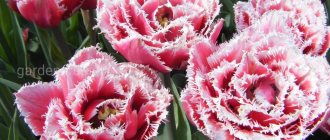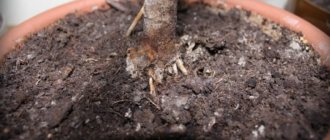Tulips are one of the first flowers that symbolize the arrival of spring. Their dense, elastic leaves are pleasing to the eye against the backdrop of black earth that has just recovered from the cold. Proper planting of tulips in the fall is the key to their early and successful flowering. Don't be afraid of difficulties: growing tulips only seems like a complicated process. In fact, even a novice gardener can cope with this mission. Follow simple rules and recommendations - and your flower garden will attract the admiring glances of neighbors from all over the area.
There are 2 ways to plant bulbs: in spring and in winter. There are more benefits to planting tulips in the fall. This is what will be discussed further.
Digging and storing bulbs
Tulips are dug up every year. Exceptions are baby bulbs, which remain in the ground for 2 years. Why is this needed: diseased specimens are discarded, appearance improves (flowers become larger), and the ability to produce children increases.
There are a number of rules for when and how excavation is carried out:
- Don’t miss the moment: you need to dig up tulips when the leaf is 2/3 dry. If you get the bulb early, it will not have time to accumulate the required supply for subsequent flowering. Late extraction is fraught with the risk that the maternal part will go deeper underground, and the children will separate from it. There is a high probability of missing or damaging planting material.
- Arm yourself with a bayonet shovel: you should stick it deep and with a “margin” around the edges so as not to damage the flowers.
- Change the bed every 3 years.
Cunning
remove the flower stalk after it has finished blooming. This will help the tulip gain strength. And the leaves themselves should not be removed under any circumstances - it is due to them that the necessary substances accumulate.
Create optimal conditions
Before planning a flower garden, you need to choose a suitable place where the flowers will be comfortable throughout the entire growing period. Tulips love:
- Sun;
- warm;
- wind protection;
- suitable soil.
They grow poorly in shady areas. The soil must be slightly alkaline, fertile, loosened, moist, and drained. Sandy loam is welcome - it creates natural additional drainage. It is better not to plant tulips on loam, clayey, sandy or rocky soils.
Choosing a place and preparing a bed
A good location of the bed and planting tulips in the fall, when and how to plant the choice will be less problematic. These flowers love sunny spaces sheltered from the winds. In spring, no puddles should form there. The soil should drain well - the best option would be loamy or sandy loam soil with a significant proportion of humus.
Cunning
asters, watermelons, melons, zucchini, cucumbers, and tomatoes are not the best predecessors for tulips.
It is worth digging up the ground to a depth of 25-30 cm, carefully removing the roots of weeds, trees and shrubs. If the soil is heavy and poor, add sand and fertilizers: compost, ash, peat, mineral complexes. Cow manure should not be used - add bird droppings instead. If the pH values are increased towards oxidation, liming is required.
The soil needs to be prepared a month before the expected planting date. This is necessary for the soil to “settle.” In a loose “cushion” there is a high probability of damaging the emerging roots. Before planting, water the ridges generously - this will completely distribute the soil.
Cunning
Sprinkle the formed rows with a thin layer of sand. This will provide additional drainage and help reduce the likelihood of rotting.
Usually this is where caring for tulips after planting in the fall ends. There is no need to cover the bed - this can lead to the bulb growing ahead of schedule, overwintering worse and blooming later. Exceptions include sudden cold weather. When the temperature drops sharply, use specialized covering material. Do not use garden waste, mulch or leaves as this may attract rodents.
Landing dates
In autumn, tulips are planted from the second half of September until the end of November. By frost, the bulbs will have time to take root firmly, but will not sprout yet. If we plant earlier, shoots will appear and freeze.
Some plant it even later, but then it is necessary to insulate it with mulch, dry leaves, sawdust, and branches on top.
Therefore, a comfortable time is a month before frost hits. The night temperature should be from 5 to 10 °C.
Do you know what happens to the bulb underground at this time? It develops a root bud that reaches almost to ground level and in this state goes into hibernation.
Here, pay attention to its development by month in the illustration below.
If for some reason we were unable to plant tulips in the fall, then we calmly plant them in the frozen ground. You can also put them in pots, which should then be put away in a cold place, for example, on a balcony or outside.
If you are used to being guided by the lunar calendar, then here are the favorable days that fall in September 2022: 18th, 19th, 23rd, 26th, 27th.
By the way, there is a miracle technology that allows you to see blooming tulips in September. It consists of the following:
- bulbs are planted in boxes in November;
- allow them to take root for 1.5 months at a temperature of +9 °C;
- place in the refrigerator and store at a temperature of -2-4 °C;
- Before planting, gradually defrost at a temperature of +12-14 °C.
After 3-4 weeks, the tulips really bloom! However, this technology also has its disadvantages:
- Thin and weak stem.
- Dim color of buds.
- Expensive and long.
Therefore, if we are not going to surprise anyone with winter tulips, we plant them in the fall, like all normal people.
How to plant
Treat your tulip bulbs before planting in the fall to protect them from fungal infections. For this purpose, special preparations are produced that can be replaced with ordinary potassium permanganate. Inspect again: healthy and diseased plants cannot be planted together. Affected bulbs must be disposed of.
Planting depth of tulip bulbs
The standard scheme for planting tulips is as follows: rows are made at a distance of 25-30 cm. Their location should fit organically into the perimeter of the flowerbed. The distance between the bulbs is 8-10 cm. Planting depth depends on the size:
- Children: 5-10 cm.
- III and II analysis: 12 cm.
- I analysis: 15 cm.
Keep in mind that small bulbs produce small flowers. To avoid being shaded by taller flowers, plant them at the edge of the flowerbed on the south side. If you like the “uncultivated” look, then there is no need for combination. Create wider spacing between flowers and enjoy the natural state of your garden.
If you are interested in landscape design, then plant tulips according to the pattern. When compiling it, take into account the timing of flowering, the diameter of the inflorescence, and the color of the petals. Think over and sketch in advance the scheme according to which you will plant the bulbs. The picture can be supplemented with other primroses.
Video “Planting tulips in autumn: diagram, depth, planting dates”
Main characteristics for flower beds and flower beds
During the distribution, where and what flowers will grow, what tulips to choose for this, you need to take into account the period of flowering and growth throughout the season. Pay attention to the color of the buds, the height of the stem, the shape and height of the flower itself. Weeds must be removed regularly. The bulbs of most varieties quickly die from the density of weed roots. Therefore, you need to choose a place where hops, wheatgrass and any other plant with climbing or urinary rhizomes do not grow.
Tiers and sandwiches: alternative planting methods
A creative approach will make any task interesting. This also applies to floriculture. Recently, unusual methods of planting tulips have been gaining popularity. They save time, decorate the garden and attract attention. In addition, they are quite simple and anyone can master them.
Planting tulips in autumn in containers
Container planting or planting in baskets simplifies the process of growing tulips. The essence of this method is to use baskets, containers and other containers instead of a flower bed or bed. They can either be dug into the ground or freely placed in any convenient place.
Advantages of this method:
- You are firmly confident that you have completely dug out the planting material. The bulbs themselves are minimally damaged and, therefore, are better stored.
- You create optimal conditions for plant growth. Relevant for infertile soils - it’s easier to create ideal conditions in a limited space.
- The likelihood of damage to the bulbs by rodents is reduced. Mice cannot overcome the barrier from below.
You can use anything as a container: plastic bottles, boxes, baskets, pots and even bags. One condition is that you need to make holes to drain excess water. Use a hot knitting needle or other similar object for this. The holes should not be large, otherwise mice will get through them.
Method of planting lasagne tulip bulbs
The second way to arrange flowers in an unusual way is tiered planting. The essence of this method is to lay the bulbs at different depths. The very first layer, starting from the bottom, is occupied by large onions. The higher the level, the smaller the size. To avoid making a mistake and planting one flower on top of another, use long thin sticks. Stick them near the planting site, and remove them after the flowerpot is completely filled. This method of combining is also called “lasagna” - the structure resembles this dish in its layering.
When composing such a composition, it is important to take into account the color, size and shape of the petals. Try to play with contrasts: smooth ones with terry ones, red ones with yellow ones. Groups of flowers united by color will look beautiful. For example, variegated with monochromatic ones: the color of the inclusions should match the monocolor of the petals of the neighboring variety. A group in which tulips are selected according to flowering dates will look impressive.
Cunning
you can combine different flowers. You can add irises, crocuses, lilies, daffodils, hyacinths and other bulbs to tulips.
Video “Methods of planting tulips”
More examples of the beauty of tulips
Burgundy tulips with white border Source 3agorod.ru
Red flowers with white fringe around the edges Source oir.mobi
Sunny flower with scarlet tongues Source mtdata.ru
Unusual black tulips Source intellectyal.ru Tiger colors of flowers with fringe Source yandex.ru
Lush pale pink flowers Source pinimg.com
Peony variety of tulips Source mykaleidoscope.ru
Lilac shades of tulips with fringe Source domashniecvety.ru
Simple tulips with a beautiful shade of purple Source foto.my.mail.ru
White petals with a pink frame Source goodfon.ru
A beautiful meadow of spring flowers Source zastavki.com For some, yellow tulips are harbingers of separation, but for others they are simply beautiful flowers Source vfl.ru
Lush clouds of fringe on pink petals Source domashniecvety.ru
Almost roses that will decorate the spring garden Source selcdn.fedsp.com
Pink tulips in flower beds with blue scatterings Source lachat.ru
Tulips in a flowerbed with white pansies Source na-dache.pro
Flowers can be grown in large clay pots Source bezgoroda.com
Purple flowers with shades of white Source fotoload.ru
Tiger and white tulips in one flower bed Source oir.mobi
Such tenderness will decorate the spring garden Source pixabay.com
It’s nice to relax on a bench in the garden next to such beauty Source goodfon.ru Burgundy flowers with white streaks Source pixabay.com
Soft pink peony tulip Source goodfon.ru
Bright carpet of yellow flowers Source etsystatic.com
Delicate meadow of white and pink flowers Source goodfon.ru
Pink and burgundy tulips in one large flower bed Source samicebeci.net
A small flower bed for decorating a garden Source 1zoom.ru Airy buds of unusual tulips Source oir.mobi
Multi-colored flower bed for a rainbow mood Source sadgrad.ru
Pink flowers in the spring garden Source dizainexpert.ru Marshmallow shades of tulips among blue primroses Source twimg.com
Burgundy garden decoration Source 1zoom.ru
Delicate white tulip heads Source centr-sadovoda.ru Glade of beautiful flowers Source wallhere.com White and purple tulips Source twimg.com Decorating a flower bed in the garden Source lykoshko.com
Tulips next to pansies Source wallhere.com
Beautiful design of a flower bed along the fence Source zelendvir.com.ua
Delicate meadow with hyacinths Source lachat.ru
Bright multi-colored flower bed Source goodfon.ru
Unusual spring garden decoration Source oir.mobi
Tulips are “friends” with different flowers Source pixabay.com
White glade of delicate flowers Source lachat.ru
White flowers with purple hyacinths Source wallhere.com Shades of pink flowers Source archidea.com.ua
Purple peony tulips Source rastenia.pro
When to plant
The timing of planting is affected by soil temperature. In the fall, the groundwork is made for subsequent flowering, so it is important to plant the bulbs in the garden on time. For all processes to start, the soil must be no colder than 10° (the lower limit is 8°). You can check the data using a depth thermometer.
In different regions, the timing of planting in open ground is different. Thus, planting tulips in the fall in the Moscow region occurs from mid-September and throughout October. The hotter the region, the closer to winter the dates shift. If, during a pre-planting inspection, you notice that the bulb is ready to actively begin to grow, it makes sense to leave it for forcing (that is, plant it in a pot and keep it at home).
In other regions, which are characterized by more severe climatic conditions, the planting period is from the end of September to mid-October. If the autumn is hot, then they are planted until the beginning of November. For example, the optimal planting of tulips in autumn in Siberia falls on the 10th-20th of October.
What should ideal bulbs look like?
When buying tulips, you should carefully inspect the bulbs. The scales should be dense, shiny, without suspicious spots or areas of mold. The bulb itself should not be soft to the touch; it is better to buy large, heavy bulbs. Plants grown from elite bulbs suffer less disease and produce more flowers.
The bottom of the bulb should not have any damage, areas of rot or mold.
Even if the bulbs at first glance do not have any flaws, before planting they should be treated in a solution of fungicides or soaked in potassium permanganate. Processing time is from 30 to 60 minutes.
A little about feeding
Feeding tulips in winter is not required, because... at this time they are in a period of rest. But in the spring, when the first tender shoots appear, they can be fed with ammonium nitrate, which will accelerate their growth. After 2 true leaves appear, we will “treat” the flowers with complex mineral fertilizer. When the buds begin to appear, you can feed them with phosphorus and potassium. But you can’t overdo it with fertilizing, as this can harm the plants.
Pay more attention to proper care of tulips, and they will delight you with their wonderful flowers for a long time. Many neighbors will envy you, looking at all this beauty. You will have a lot of fun admiring them. Good luck to you and your beautiful "friends".
Caring for tulips after planting
Flowers of the Lily family are unpretentious. However, without proper care, tulip buds do not open, the stems begin to rot, and over time the bulb suffers. To prevent this from happening, the plant must have constant access to sunlight. Soil moisture plays an important role. If autumn is rainy, there is no need to additionally water the soil. In arid areas, it is necessary to moisten the soil for the first time after 2 weeks, but do not overwater.
After planting, you need to add fertilizer to the soil. As a top dressing, you can use organic products (humus, manure) or special solutions with potassium and phosphorus. For 1 m³ of bed you will need 10 kg of compost or 200 g of wood ash. The dosage of complex fertilizers is always indicated on the packaging. It is important not to overdo it with the amount of fertilizing, because... microelements accumulate in the soil. In spring this can have an adverse effect on the tulips.
How to choose seed material
The germination of tulips will primarily be determined by the quality of the seed material - the bulbs. Seed material purchased in the spring, as a rule, remains after autumn sales - unsold goods. Therefore, it is better to buy bulbs in the fall, as well as plant them.
When choosing, you need to focus on the absence of mechanical damage and the thickness of the scales. The bulbs must be mature, but with a particularly thick cover, the bulbs will take a long time to germinate and may even die.
It is better to take large and medium-sized bulbs with medium-thick scales. The percentage of overwintering of small bulbs is much lower (40 - 60%, while for large seed material it is 100%). At the bottom of the bulb, tubercles that subsequently form roots should be noticeable.
It is better not to use damaged bulbs that raise doubts. Because if they get sick, they can infect nearby plants.
For regions of Siberia, central Russia and the Trans-Urals, it is better to choose frost-resistant varieties - Darwin hybrids, tulip varieties of the Triumph, Traveler, Apeldoorn and others.
Tulips cannot be grown in one place for more than one year.
According to the rules of agricultural technology, tulips can be returned to the same place no earlier than after 3-5 years. But, if your plot is small and there is nowhere else to plant these flowers, and you want to admire them every year, then you need to pay special attention to the health of these flowers. To do this you need:
- Absolute health of bulbs prepared for planting
- Be sure to dig up faded bulbs every year.
- Carefully remove all scales from the onions, all their roots and leaves from this place
- Regularly inspect the plantings and immediately remove diseased plants, as well as their roots, the bulb and the soil around it. The resulting hole must be filled with 0.5% hot 70-100° C solution of potassium permanganate. But this must be done carefully so as not to burn the roots of surrounding plants. Then, in this place, be sure to plant plants such as nasturtium, marigolds or calendula, because they actively destroy pathogenic microflora.
At what distance is it best to plant tulips?
The distance between tulips when planting also depends on their size. If they are large, it doesn’t matter whether they are our own or purchased, then we plant them less often so that they do not interfere with the development of either ourselves or our neighbors.
- We plant large tulips at a distance of no less than 10 cm from one another.
- Smaller ones should be planted no closer than 5-8 cm
- When planting tulips in groups (consisting of the same variety) in a flowerbed, it is better to leave larger distances, up to 20 cm, between these groups, so that it is easier to care for them and, subsequently, not to mix bulbs or children of different varieties.
Location requirements
It is equally important to choose a good planting site. It is necessary not only to design a beautiful garden bed that is convenient for the gardener, but also to select good soil and an area suitable for flowers.
When choosing, you need to pay attention to the following points :
- You need to choose a sunny, well-lit area, protected from the wind.
- It is advisable to plant tulips on a hill or on a slope so that excess water drains away. Low-lying or overly wet soils are not suitable, as the bulbs will begin to rot. In the latter case, it is worth arranging high beds.
- The soil should be loose, with good drainage, slightly alkaline or neutral. Acidic soil is not suitable.
- Sandy and loamy soils are well suited. If the soil is clayey or too heavy, it can be improved by adding peat or river sand (5 kg per 1 sq. m); if it is sandy, add clay chips (about a bucket per 1 sq. m).
- You should not plant tulips in beds where cucumbers, zucchini, melons, tomatoes, watermelons or asters previously grew.
Advice!
When choosing the size of a flower bed, you should focus on the desired effect. For example, to achieve a “carpet” effect you will need up to 100 bulbs per 1 square meter. meter.
The most common mistakes when planting tulips
Most often people make the following mistakes when planting tulips:
- Late planting. If you plant the bulbs in open ground later than the recommended time, they will not have time to take root.
- Incorrect depth. The proximity of the bulbs to the surface causes them to freeze in winter. If you deepen them too much, the growing season will slow down and flowering will come late.
- Use of damaged bulbs. If you did not buy planting material, but dug it up from your garden, carefully inspect it for stains, cracks and other signs of disease. Even one diseased bulb can infect the entire area. If you have any doubts about a particular item, it is best to throw it away.
Don't make mistakes when planting
Tulips are the favorite flowers of most women. Follow all the recommendations described in this article, and your flowerbed will sparkle with bright colors when spring comes.
Also relevant topics about tulips:
- How to care for tulips in a vase
- Tulips have bloomed: when to dig up bulbs after flowering
- Yellow tulips: why they give as gifts
- How to grow tulips from seeds at home
- Forcing tulips at home by March 8











